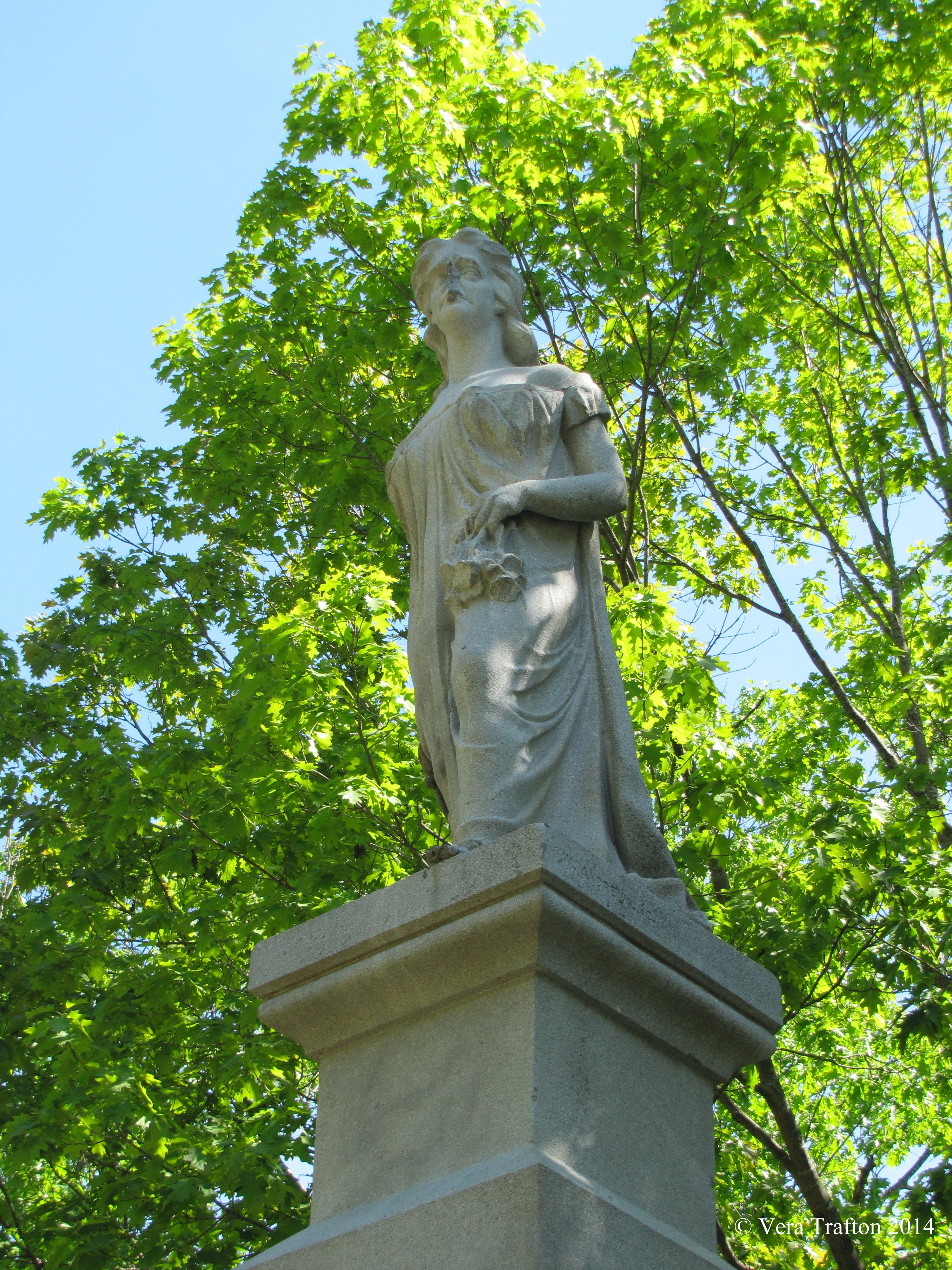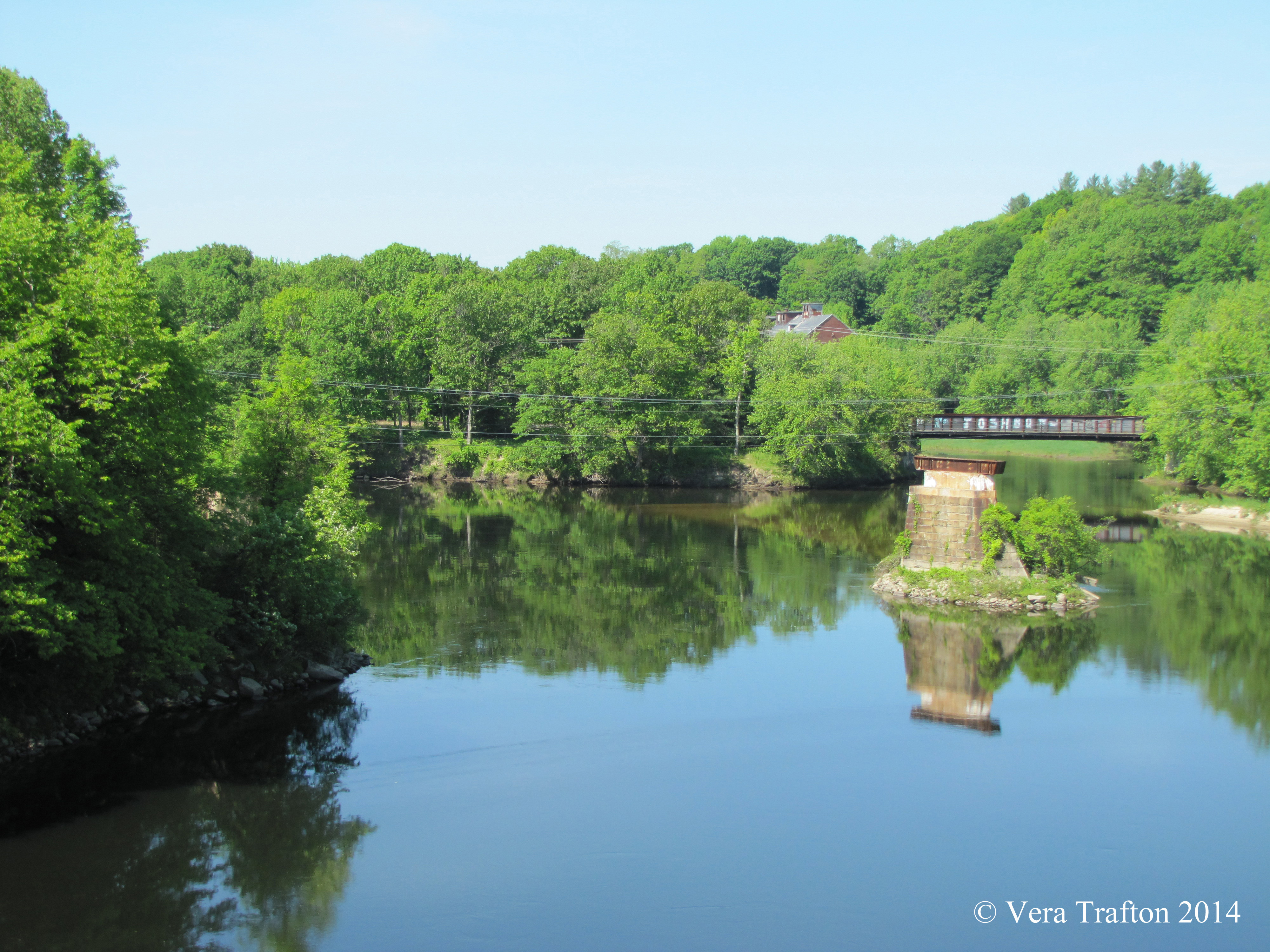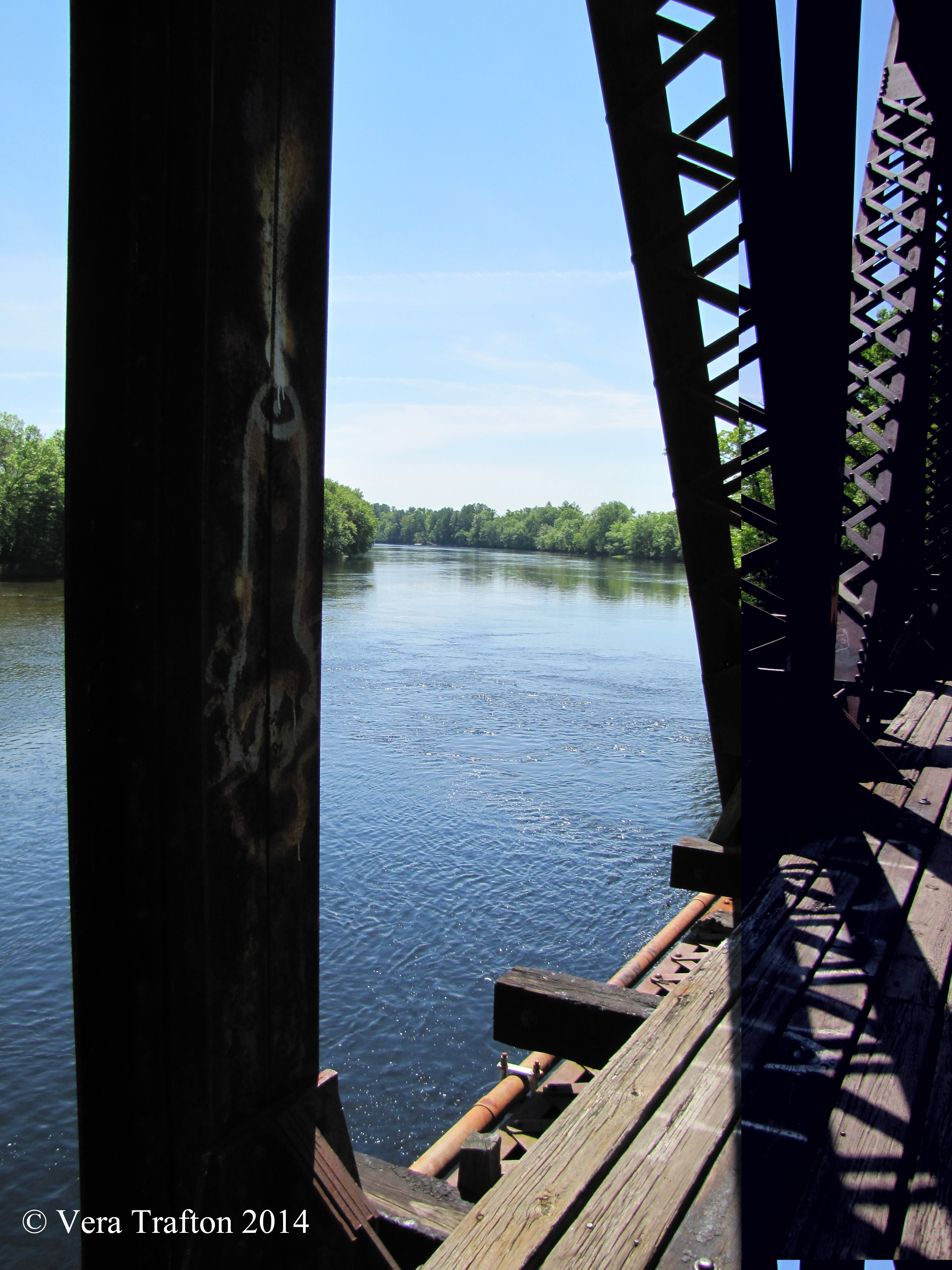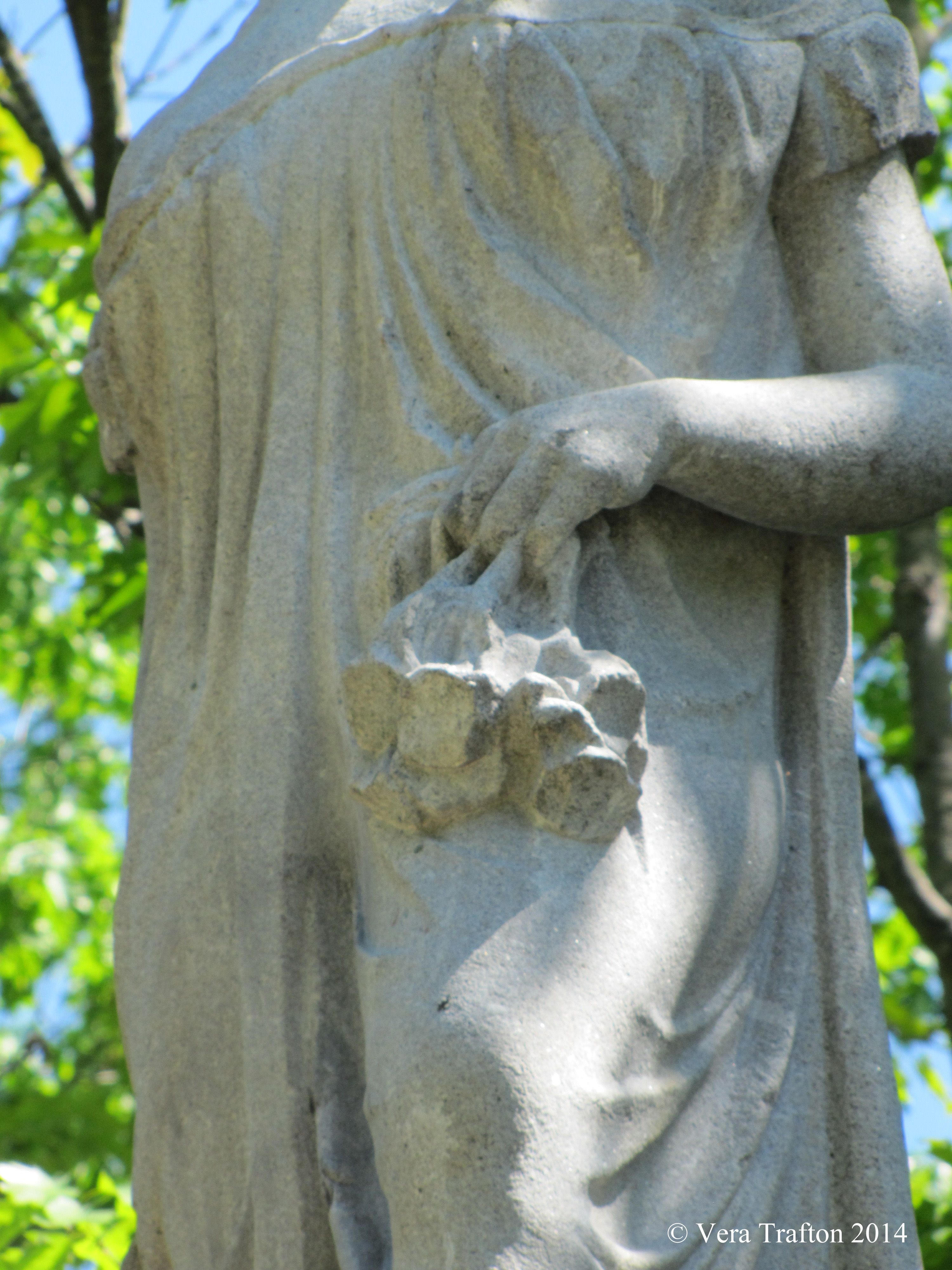
New England is sown thick with monuments to the dark and bloody times that began with the Pequot War in 1636 and did not end entirely until 1760, when the French surrendered Canada–one hundred and twenty four years of intermittent but continual war, sometimes declared and sometimes not, pitting English settlers, Native American groups, and the French in Canada against each other in varying combinations. Most of the monuments to these dark times are more or less forgotten today and are in themselves of little interest, mere plaques hidden in the grass, lonely pillars, sanitized, generalized, impersonal, cold reminders, with no aesthetic value or power to conjure up the often terrible events they commemorate.

A notable exception is the monument on Duston Island at the confluence of the Contoocook and Merrimack Rivers in Boscawen, New Hampshire. This monument, erected in 1874, honors a woman once famous throughout New England–Hannah Duston (1657-1736), who was taken captive by Native Americans during a raid on Haverhill, Massachusetts on March 15, 1697, and who witnessed a lifetime’s worth of horrors on that day. Forced from the bed where she was lying in with her week-old baby, she saw her house pillaged and set on fire, her husband and seven of her children driven off, perhaps to their deaths, her baby’s brains dashed out against a tree. Nevertheless, as a grieving captive on the hard trip north through the wilderness, she found the strength within herself to engage two of her fellow captives (a neighbor named Mary Neff, and a fourteen year old boy named Samuel Leonardson) in a plot to kill their captors and escape, which they did one night on Duston Island–or so tradition identifies the place–and returned to Haverhill with ten scalps.


That the monument to these dark and bloody events from New England’s dark and bloody times still proves capable of engaging us both intellectually and emotionally derives almost entirely from the expressive power of the larger than life size statue of Hannah that crowns it. Carved from white granite quarried nearby, this statue is the masterpiece of the nearly forgotten sculptor William Andrews (1836-1927) of Lowell, Massachusetts, and the brain child of an attorney named Robert Boody Caverly (1806-1887), also from Lowell and also nearly forgotten, who devoted his leisure to studying and writing about colonial New England, especially its wars with the native Americans. It was Caverly who conceived the project of a monument to Hannah to be placed on Duston Island, who rallied a small group of influential friends to the cause, who organized a fund raising effort that brought in nearly $6,000 from over 450 supporters, some of them from as far away as Buffalo, New York, and Louisville, Kentucky, who wrote a book entitled Heroism of Hannah Duston Together with the Indian Wars of New England (published in 1875) to explain his understanding of Hannah, and who hired his fellow Lowellian, Andrews, to set that understanding in stone.
was Caverly who conceived the project of a monument to Hannah to be placed on Duston Island, who rallied a small group of influential friends to the cause, who organized a fund raising effort that brought in nearly $6,000 from over 450 supporters, some of them from as far away as Buffalo, New York, and Louisville, Kentucky, who wrote a book entitled Heroism of Hannah Duston Together with the Indian Wars of New England (published in 1875) to explain his understanding of Hannah, and who hired his fellow Lowellian, Andrews, to set that understanding in stone.

My thesis today is that this statue, which was the fruit of the collaboration of these two rather obscure men, both of whom operated outside the charmed intellectual and artistic circles centered on Beacon Hill and Brattle Street, is an exceptionally interesting example of public art, whose aesthetic quality has been undervalued and whose meaning as a memorial has been misunderstood, with the result that the statue has suffered from periodic neglect and even antagonism. Periodic neglect of the site, Duston Island, which, in spite of the efforts of local volunteers and the New Hampshire State Bureau of Historic Sites has at times been overgrown, littered, and defaced by graffiti. Lately, it is true, a concerted effort from many quarters has reduced the brush and litter and cleaned off some of the graffiti, making the monument a far more attractive place to visit, but  a permanent solution to the monument’s vulnerability has yet to be found. For example, the island remains accessible to the public only by private boat or by venturing on foot over one or the other of two abandoned railroad bridges, a means of approach which may understandably discourage some lovers of public sculpture while at the same time failing to deter those who love it only to deface it. Hannah has lost her nose to marksmen at least twice and has also suffered other indignities. Those ugly stains on her face are the remains of earlier efforts to repair her nose. However, it is not those blemishes that trouble her eyes and give her face that haunted look.
a permanent solution to the monument’s vulnerability has yet to be found. For example, the island remains accessible to the public only by private boat or by venturing on foot over one or the other of two abandoned railroad bridges, a means of approach which may understandably discourage some lovers of public sculpture while at the same time failing to deter those who love it only to deface it. Hannah has lost her nose to marksmen at least twice and has also suffered other indignities. Those ugly stains on her face are the remains of earlier efforts to repair her nose. However, it is not those blemishes that trouble her eyes and give her face that haunted look.
Far more serious than casual vandalism, Andrews’ presentation of Hannah with a hatchet in one hand and ten scalps in the other, a stark reminder of what she did to free herself, has been a stumbling block to understanding. From the beginning, when the statue was unveiled in 1874,
most commentators have assumed that it was intended as a straight-forward celebration of Hannah’s famous deed, with no irony or complexity, and have approved or disapproved according to their moral and political views,
 praising the work as a tribute to a woman’s justifiable act of heroism or condemning it as a glorification of bloodshed and a triumphalist symbol of American racism, imperialism, and greed. Each of these responses contains an element of truth; neither, however, does justice to the subtlety of Andrews’ art or the complexity of Caverly’s vision that lies behind it. Andrews’ depiction of Hannah is a testimony both to her heroism and to the horror of what she has experienced–both what has been done to her and what she herself, compelled by tragic necessity, has done to others. Indeed, it is in the portrayal of Hannah’s tragic self-awareness that, I would argue, the statue’s highest achievement resides.
praising the work as a tribute to a woman’s justifiable act of heroism or condemning it as a glorification of bloodshed and a triumphalist symbol of American racism, imperialism, and greed. Each of these responses contains an element of truth; neither, however, does justice to the subtlety of Andrews’ art or the complexity of Caverly’s vision that lies behind it. Andrews’ depiction of Hannah is a testimony both to her heroism and to the horror of what she has experienced–both what has been done to her and what she herself, compelled by tragic necessity, has done to others. Indeed, it is in the portrayal of Hannah’s tragic self-awareness that, I would argue, the statue’s highest achievement resides.
We can begin to illustrate this general point by comparing the statue that we actually have on Duston Island with what we might have had if Caverly and Andrews, those obscure and eccentric men, had followed more conventional models. For example, they might have followed the lead of Cotton Mather, who probably met Hannah in  Boston a few weeks after her escape and
who told her story in a famous sermon as well as in an influential chapter of his Magnalia Christi Americana, published in 1702. Mather defines the quality of Hannah’s heroism by comparing her to Jael, a type of admirably strong female character from the Old Testament. Jael served God and Israel by luring the Canaanite general Sisera into her tent in order to kill him, which she did by driving a tent peg into his temple while he slept (Judges 4:17 22). By invoking Jael, Mather associates Hannah’s killing and scalping of her captors with God’s will and thus removes moral and emotional complexity from a gruesome and potentially troubling story. We can see the artistic result in the gorgeous but rather soulless painting of Jael and Sisera (1620) by Artemisia Gentileschi in the Museum of Fine Arts in Budapest. Jael smiles with satisfaction as she taps a fancy spike into the head of sleeping Sisera. Andrews and Caverly might have given Hannah a face of similar serenity had they wanted to affirm her bloody deed unequivocally, as Mather does, but instead they gave her a pained and haunted look that complicates and renders morally more interesting the image of her heroism.
Boston a few weeks after her escape and
who told her story in a famous sermon as well as in an influential chapter of his Magnalia Christi Americana, published in 1702. Mather defines the quality of Hannah’s heroism by comparing her to Jael, a type of admirably strong female character from the Old Testament. Jael served God and Israel by luring the Canaanite general Sisera into her tent in order to kill him, which she did by driving a tent peg into his temple while he slept (Judges 4:17 22). By invoking Jael, Mather associates Hannah’s killing and scalping of her captors with God’s will and thus removes moral and emotional complexity from a gruesome and potentially troubling story. We can see the artistic result in the gorgeous but rather soulless painting of Jael and Sisera (1620) by Artemisia Gentileschi in the Museum of Fine Arts in Budapest. Jael smiles with satisfaction as she taps a fancy spike into the head of sleeping Sisera. Andrews and Caverly might have given Hannah a face of similar serenity had they wanted to affirm her bloody deed unequivocally, as Mather does, but instead they gave her a pained and haunted look that complicates and renders morally more interesting the image of her heroism.
Or, had they wanted to express the American triumphalism that some have accused them of, they might have looked for inspiration to Benvenuto Cellini’s bronze “Perseus with the Head
of Medusa” (1545), perhaps the supreme example of triumphalist political propaganda in western
art. Cellini’s masterpiece, a marvel of technical expertise, stands in the Loggia dei Lanzi in
Florence, sword at the ready, severed head held high, headless torso of the monstrous “other”  trampled under foot, and well understood throughout Italy to be an allegorical glorification of
Cosimo I dei Medici’s successful and bloody subversion of the Florentine Republic, by which he
made himself its sole ruler, the city’s first prince. The similarities to Andrews’ Hannah are remarkable–hero, weapon, grisly trophy, all on a pedestal–but the differences of course are what matter. Cellini was in his own day, and still is, an artist of internationalrenown, whom it may seem ludicrous to introduce as a foil to the artistic virtues of Andrews, the practically unknown provincial from Lowell, but technical expertise is only one aesthetic value and may even become a defect when it adorns intellectual or spiritual vacuity–or worse. Andrews is not Cellini’s equal
in craftsmanship, but he possesses considerable expressive powers of his own, and his statue of Hannah is engaged with deeper matters than Cellini touches in his Perseus–with the state of Hannah’s soul and the meaning of her experience as Caverly presented it in his Heroism of Hannah Duston.
trampled under foot, and well understood throughout Italy to be an allegorical glorification of
Cosimo I dei Medici’s successful and bloody subversion of the Florentine Republic, by which he
made himself its sole ruler, the city’s first prince. The similarities to Andrews’ Hannah are remarkable–hero, weapon, grisly trophy, all on a pedestal–but the differences of course are what matter. Cellini was in his own day, and still is, an artist of internationalrenown, whom it may seem ludicrous to introduce as a foil to the artistic virtues of Andrews, the practically unknown provincial from Lowell, but technical expertise is only one aesthetic value and may even become a defect when it adorns intellectual or spiritual vacuity–or worse. Andrews is not Cellini’s equal
in craftsmanship, but he possesses considerable expressive powers of his own, and his statue of Hannah is engaged with deeper matters than Cellini touches in his Perseus–with the state of Hannah’s soul and the meaning of her experience as Caverly presented it in his Heroism of Hannah Duston.
Heroism of Hannah Duston is a long, complex, and sometimes contradictory book. Caverly was not always as disciplined a writer as one could wish, but the main lines of his interpretation of Hannah and what he wished to commemorate in her monument and especially in the statue whose execution he confided to Andrews come through clearly enough. In this short presentation a summary of those ideas and of the strategies by which Andrews embodied them in stone will have to suffice. Caverly’s goals, which he tells us he had contemplated for “many years,” were twofold: first, to raise a monumental statue to Hannah on the island where, according to long-standing tradition, she had performed the deeds that made her famous; and second, to express through that statue his sense of the heroism that she represented and that he believed could also be found to one degree or another in the lives of many women–the “old New England mothers,” as Caverly calls them–who lived through the dark and bloody times from 1636 to 1760: women like Mary Neff, the neighbor who was captured with Hannah and became her ally in escape, helping to kill and scalp their Native American captors; and women like Hannah Bradley, whose story Caverly recounts in detail–how she was taken twice by raiders, how she escaped once and once was ransomed, how she, like Hannah, saw her infant murdered, how she killed a Native American raider by scalding him with boiling soap, and how, on still another occasion when her house was attacked, she fought with a musket like a man and shot a raider at point blank range as he broke through her door.
It was the courage and spirit of such women that Caverly wanted to commemorate in a monument to Hannah, but he also wanted to do so in a way that would not sentimentalize them. He wanted a monument, and especially a statue of Hannah, that would not turn her or the women she represented into plaster images of conventional goodness, or suggest that their heroic accomplishments represented uncomplicated victories of good over evil from which the women themselves emerged unscathed. Caverly had meditated at length on New England’s dark and bloody times, and like most of his thoughtful contemporaries–like Whittier, like Longfellow, like Hawthorne–had come to the conclusion (long before contemporary scholars) that the European settlement of America was a kind of invasion, whether deliberate or not, and that once the fighting broke out none of the participants was wholly blameless. The “aggressive intrusions of English settlers, oft repeated,” he wrote, “the cruel interference of the Canadian French, who tainted the tribes,” and “the unbridled infirmities of the tribes themselves,” combined to turn the land into “one common battlefield of blood,” and it was on that field that Hannah and the “old New England mothers” played their part and were drawn by the passions and the necessities of the moment to participate in bloody deeds in which they never would have participated otherwise, deeds that would seem shocking, even morally reprehensible, to Caverly’s contemporaries. Of course, Hannah and women like her in her time might have chosen to endure the suffering imposed on them and made no effort to resist, as some, no doubt, would have had them do, but their heroic spirit, which Caverly considered “divine,” would not countenance such passive martyrdom, and as a result they were trapped in a situation they could not control, in which they could not protect themselves or their families, except by stooping to participate in the dark and bloody world in which they found themselves. In Caverly’s view, this was the essence of their tragic situation, which he believed they recognized and accepted, and he wanted a monument to Hannah that would express their extraordinary virtues to a world that might otherwise fail to understand and value them, that might even ignore them.
As for Andrews, he gave expressive form to Hannah’s tragic predicament by working the granite that according to Caverly 
 “had held concealed the image of Hannah Duston for thousands of years” into a figure of that is full of tensions and ambiguities and terrors, even heightening the terrors that he found in Caverly’s account. As Andrews presents her,for example, we are to see her as still on the island, as Caverly wanted her to be. Apparently she is just leaving the scene of blood, full of apprehension, but she is ominously alone. Her accomplices have disappeared–somehow, we know not how–leaving her by herself to bear the burden of her experience and indeed the experience of others too, going back at least to the day of the raid, which her figure is designed to recall. She wears a gown such as she might have worn that day when she was pulled from her bed to watch her house burned. One of her feet is bare, recalling the tradition that as she left behind her burning home she lost a slipper in the snow and was forced to continue without it. She leans forward as though in haste to put Duston Island and all that it represents behind her, but she seems frozen. The short step of her left foot onto which her weight has shifted checks her
momentum. She looks to her left as in apprehension, but of course there is nothing there except the trees and perhaps the “phantom shadows,” the ghosts, that Caverly tells us stalked the island
after the killings that night. Down her left leg her gown falls in stiff folds like shackles to prevent her escape. Behind her, a cloak that hangs down her back gathers in a heavy pile. Her hatchet, the instrument of her heroic escape but also of the acts she would prefer to forget, hangs at her side, not brandished, but not abandoned either, as though she may need it again, indeed, may carry it forever, which of course she will. With an awkward, almost dainty, lady-like gesture she holds the scalps against her waist as though they were a bunch of flowers, wilted, heads down, their blooms resting lightly on her left thigh, the leg that holds her back. The cut of her gown, exposing one breast, reminds us that she is a mother, and that she will never again hold the baby with whom she was lying in not long ago, and whom the hatchet and the scalps have replaced.
“had held concealed the image of Hannah Duston for thousands of years” into a figure of that is full of tensions and ambiguities and terrors, even heightening the terrors that he found in Caverly’s account. As Andrews presents her,for example, we are to see her as still on the island, as Caverly wanted her to be. Apparently she is just leaving the scene of blood, full of apprehension, but she is ominously alone. Her accomplices have disappeared–somehow, we know not how–leaving her by herself to bear the burden of her experience and indeed the experience of others too, going back at least to the day of the raid, which her figure is designed to recall. She wears a gown such as she might have worn that day when she was pulled from her bed to watch her house burned. One of her feet is bare, recalling the tradition that as she left behind her burning home she lost a slipper in the snow and was forced to continue without it. She leans forward as though in haste to put Duston Island and all that it represents behind her, but she seems frozen. The short step of her left foot onto which her weight has shifted checks her
momentum. She looks to her left as in apprehension, but of course there is nothing there except the trees and perhaps the “phantom shadows,” the ghosts, that Caverly tells us stalked the island
after the killings that night. Down her left leg her gown falls in stiff folds like shackles to prevent her escape. Behind her, a cloak that hangs down her back gathers in a heavy pile. Her hatchet, the instrument of her heroic escape but also of the acts she would prefer to forget, hangs at her side, not brandished, but not abandoned either, as though she may need it again, indeed, may carry it forever, which of course she will. With an awkward, almost dainty, lady-like gesture she holds the scalps against her waist as though they were a bunch of flowers, wilted, heads down, their blooms resting lightly on her left thigh, the leg that holds her back. The cut of her gown, exposing one breast, reminds us that she is a mother, and that she will never again hold the baby with whom she was lying in not long ago, and whom the hatchet and the scalps have replaced.
Her face, even in its current mutilated condition, expresses apprehension and grief combined with strength and determination. Hers is a woman’s face such as one might have encountered in any New England village in the seventeenth and eighteenth centuries, or such as one might have met or might meet in any place where dark and bloody times have been or are afoot and where women must respond with unaccustomed, tragic heroism, fighting fire with fire, or losing all. One can encounter such faces today. When we gaze on the tragic and heroic face of Hannah Duston as rendered by William Andrews, moreover, we are looking at the face of the first statue in the United States erected in honor of a woman (1874). For its historic importance as well as for its psychological and moral depth, we should value it and take care of it.
